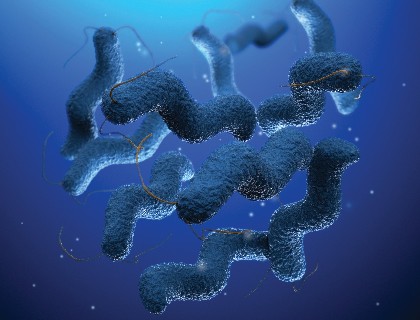The profile of a pathogen - Campylobacter
PROFILE - 15TH NOVEMBER 2016
Campylobacter is the genus of bacteria known to doctors as one of the most common causes of food poisoning in the world
The technical name for a disease caused by campylobacter is campylobacteriosis, and while this is very rarely life threatening for most of the population, the symptoms can be unpleasant to say the least, responsible for millions of days off school and work every year.
People usually start feeling ill two to five days after infection, but this can be as much as 10. The most common symptoms of campylobacter infections include diarrhoea, abdominal pain, fever, headache, nausea and vomiting, with the symptoms typically lasting three to six days.

Pathogen: A bacterium, virus, or other micro organism that can cause disease. Micro-aerobic environment: An environment in which the concentration of oxygen is less than that in the air. Gastrointestinal tract: The organ system responsible for transporting and digesting food and drink.
The reason for the bacteria’s success is that they live happily in intestinal tracts of poultry, cattle and pigs—our most popular sources of meat—while causing the animals themselves no harm. It is only when ingested by humans that bad things start to happen.
The presence of spiral-form bacteria in the stools and large intestines of diarrhoea sufferers was first described in 1886 by German-Austrian paediatrician Theodor Escherich. The genus was first described in 1963, although the organism itself was not isolated until 1972.
There are—as we speak—17 species and six subspecies of the campylobacter genus. This not-so-happy family comes in a variety of shapes and sizes. Look at them through a microscope and you will see spirals, s-shapes, curves, and rod-shaped bacteria swimming happily around in front of your lens. The real troublemakers as far as humans are concerned are campylobacter jejuni and campylobacter coli, which are found in the majority of cases of human campylobacteriosis.
Most bacteria prefer a micro-aerobic environment containing between 3-10% oxygen, and unfortunately for us parts of our lower gastrointestinal tract sit nicely between 2-7%, making us the perfect hosts for these unwelcome guests.
With a bit of care, it is easy to neutralise campylobacter before it gets into your system and starts setting up home. Buy your meat from a reliable source—dodgy slaughter practices can be a factor in infection—and make sure it is cooked properly. This does not mean serving up meat that looks like it has been pulled from a blast furnace—just ensure it is cooked through to the middle. It is easy to find the minimum temperatures different meats should reach. If you also wash your hands often when handling raw meat, any risk of getting ill will be greatly reduced.
Once campylobacteriosis is up and running there is not much you can do. Just let the disease run its course, drinks lots of water and accept that your resolution to never, ever eat meat again will only last a few days longer than the symptoms you are suffering.